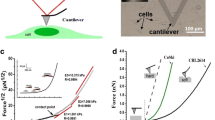Abstract
To investigate the nanoscale mechanical properties of exfoliated cervical epithelial cells from patients to further reveal the pathogenesis of cervical cancer and help early diagnose. Exfoliated cells were collected from nine patients with chronic cervicitis or CIN1(control group), 30 patients with CIN2–3 (CIN 2–3 group), and 13 patients with cervical cancer (cervical cancer group). Stiffness of the cells was determined by atomic force microscope (AFM). Expression of P16INK4A was studied by immunocytochemistry. Environmental scanning electron microscopy was performed to observe the surface microtopography of the exfoliated cells. Young’s modulus was measured for cells exfoliated from control and patients with CIN 2–3 and cervical cancer by AFM. The results showed that with increasing cervical lesions, the Young’s modulus of the exfoliated cervical cells increased (P < 0.05). The modulus of the exfoliated cells was significantly decreased in the three patients 1 year after the surgery compared with the value before the surgery. Expression of P16INK4A in the exfoliated cells had not been statistically significant. Squamous cells from cervical cancer group had dense and disordered microvilli without clear microridges compare to other groups. The Young’s modulus is increased from the control group, to CIN2–3 and cervical cancer groups, suggesting that the stiffness of cervical epithelial cells increases gradually with increasing cervical lesions. The changes in the mechanical properties of the exfoliated cells occur earlier than the changes in cell morphology. Therefore, analysis of mechanical properties of the exfoliated cells may be used to aid early diagnosis of the cancer.






Similar content being viewed by others
References
Ito T, Ishizuka T, Suzuki K, Ikoma Y, Saito J, Onuma M, Miwa T, Hashiba Y, Kuno N, Horibe N, Mizuno N, Ishikawa K, Kazeto S. Cervical cancer in young Japanese women. Arch Gynecol Obstet. 2000;264:68–70.
Frega A, Stentella P, De Ioris A, Piazze JJ, Fambrini M, Marchionni M, Cosmi EV. Young women, cervical intraepithelial neoplasia and human papillomavirus: risk factors for persistence and recurrence. Cancer Lett. 2003;196:127–34.
Arbyn M, Antoine J, Mägi M, Smailyte G, Stengrevics A, Suteu O, Valerianova Z, Bray F, Weiderpass E. Trends in cervical cancer incidence and mortality in the Baltic countries, Bulgaria and Romania. Int J Cancer. 2011;128:1899–907.
Sigurdsson K. Cervical cancer: cytological cervical screening in Iceland and implications of HPV vaccines. Cytopathology. 2010;21:213–22.
zur Hausen H. Papillomaviruses and cancer: from basic studies to clinical application. Nat Rev Cancer. 2002;2:342–50.
Mechanics Jonietz E. The forces of cancer. Nature. 2012;491:S56–7.
Eslami S, Zareian R, Jalili N. Integrated automated nanomanipulation and real-time cellular surface imaging for mechanical properties characterization. Rev Sci Instrum. 2012;83:105002. doi:10.1063/1.4757115.
Plodinec M, Loparic M, Monnier CA, Obermann EC, Zanetti-Dallenbach R, Oertle P, Hyotyla JT, Aebi U, Bentires-Alj M, Lim RY, Schoenenberger CA. The nanomechanical signature of breast cancer. Nat Nanotechnol. 2012;7:757–65.
Ramachandran S, Quist AP, Kumar S, Lal R. Cisplatin nanoliposomes for cancer therapy: AFM and fluorescence imaging of cisplatin encapsulation, stability, cellular uptake, and toxicity. Langmuir. 2006;22:8156–62.
Afrin R, Alam MT, Ikai A. Pretransition and progressive softening of bovine carbonic anhydrase II as probed by single molecule atomic force microscopy. Protein Sci. 2005;14:1447–57.
Sun Z, Martinez-Lemus LA, Trache A, Trzeciakowski JP, Davis GE, Pohl U, Meininger GA. Mechanical properties of the interaction between fibronectin and alpha(5)beta(1)-integrin on vascular smooth muscle cells studied using atomic force microscopy. Am J Physiol Heart Circ Physiol. 2005;289:H2526–35.
Chang YR, Raghunathan VK, Garland SP, Morgan JT, Russell P, Murphy CJ. Automated AFM force curve analysis for determining elastic modulus of biomaterials and biological samples. J Mech Behav Biomed Mater. 2014;37:209–18.
Dufrêne YF, Lee GU. Advances in the characterization of supported lipid films with the atomic force microscope. Biochim Biophys Acta. 2000;1509:14–41.
Zhang X, Chen A, De Leon D, Li H, Noiri E, Moy VT, Goligorsky MS. Atomic force microscopy measurement of leukocyte-endothelial interaction. Am J Physiol-Heart C. 2004;286:H359–67.
Cross SE, Jin YS, Rao J, Gimzewski JK. Nanomechanical analysis of cells from cancer patients. Nat Nanotechnol. 2007;2:780–3.
Lekka M, Laidler P, Ignacak J, Łabedz M, Lekki J, Struszczyk H, Stachura Z, Hrynkiewicz AZ. The effect of chitosan on stiffness and glycolytic activity of human bladder cells. BBA-Mol Cell Res. 2001;1540:127–36.
Zhang G, Long M, Wu ZZ, Yu WQ. Mechanical properties of hepatocellular carcinoma cells. World J Gastroenterol. 2002;8:243–6.
Fuhrmann A, Staunton JR, Nandakumar V, Banyai N, Davies PC, Ros R. AFM stiffness nanotomography of normal, metaplastic and dysplastic human esophageal cells. Phys Biol. 2011;8:015007. doi:10.1088/1478-3975/8/1/015007.
Regauer S, Reich O. CK17 and p16 expression patterns distinguish (atypical) immature squamous metaplasia from high-grade cervical intraepithelial neoplasia (CIN III). Histopathology. 2007;50:629–35.
Kasas S, Wang X, Hirling H, Marsault R, Huni B, Yersin A, Regazzi R, Grenningloh G, Riederer B, Forrò L, Dietler G, Catsicas S. Superficial and deep changes of cellular mechanical properties following cytoskeleton disassembly. Cell Motil Cytoskeleton. 2005;62:124–32.
Bhadriraju K, Hansen LK. Extracellular matrix- and cytoskeleton-dependent changes in cell shape and stiffness. Exp Cell Res. 2002;278:92–100.
Yamane Y, Shiga H, Haga H, Kawabata K, Abe K, Ito E. Quantitative analyses of topography and elasticity of living and fixed astrocytes. J Electron Microsc (Tokyo). 2000;49:463–71.
Henry MR, de Mesy Jensen KL, Skoglund CD, Armstrong DW. Chlamydia trachomatis in routine cervical smears. A microscopic and ultrastructural analysis. Acta Cytol. 1993;37:343–52.
Rubio CA. Exfoliating cervicovaginal surface. II. Scanning electron microscopical studies during estrous-cycle in mice. Anat Rec. 1976;185:359–72.
Acknowledgments
This work was supported by grants from the National Natural Science Foundation of China (No. 81472429) and National Basic Research Program of China (973 Program, 2013CB933702).
Conflict of interest
There is also no conflict of interest involved in this study.
Author information
Authors and Affiliations
Corresponding authors
Additional information
Yong-xia Ding and Yuan Cheng are Co-first authors.
Rights and permissions
About this article
Cite this article
Ding, Yx., Cheng, Y., Sun, Qm. et al. Mechanical characterization of cervical squamous carcinoma cells by atomic force microscopy at nanoscale. Med Oncol 32, 71 (2015). https://doi.org/10.1007/s12032-015-0507-0
Received:
Accepted:
Published:
DOI: https://doi.org/10.1007/s12032-015-0507-0




